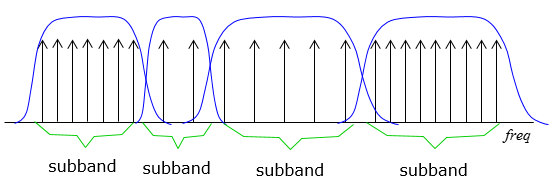|
|
||
|
f-OFDM stands for 'Filtered OFDM'. This term has confused me so much. Basically most of 5G waveform candidates use a kind of filter. The difference among them is what kind of filter is used and how the filtering applies. The word 'Filtered' in f-OFDM doesn't give me any special meaning. Anyway in some case, name is not so important... the important thing is the real meaning/contents behind the name. The real meaning behind f-OFDM can be illustrated as below. As you see here, in f-OFDM.. a band can be devided into multiple subbands. Each of the bands can have different bandwidth. Another point you should notice that each subband is made up of multiple subcarriers and the frequency spacing between the subcarriers can differ with each subband. Combining these subband flexibility and subcarrier flexibility, you can create very flexible structure of subframe that can carries the different types of service data within the same subframe. Based on the subframe requirement for 5G, it is likely that this kind of flexible waveform will be adopted in 5G.
A more detailed (probably clearer) illustration showing the fundamental difference between f-OFDM and conventional OFDM can be illustrated as below (Ref [1]). As you see here, in conventional OFDM the whole band is made up of a single block and the frequency spacing between each subcarrier are all same (labeled as delta f). In contrast, in f-OFDM, the whole band is made up of multiple subblock (subband). The subcarrier spacing in each subband are different (e.g, the subcarrier spacing for N1 subband is delta_f/2 and the subcarrier spacing for Nk is 4*delta_f) and each subband has its own CP (the length of each CP may vary as well) and each subband is applied by its own filter. Obviously, the main advantage of this waveform would be flexibility and the main disadvantage would be the complexity of structure and implementation.
Reference[1] 1st 5G Algorithm Innovation Competition-F-OFDM (Altera) [2] Filtered-OFDM Enabler for Flexible Waveform in The 5th Generation Cellular Networks Xi Zhang∗, Ming Jia , Lei Chen∗ , Jianglei Ma , Jing Qiu∗ ∗Chengdu Research & Development Centre, Huawei Technologies Co., Ltd., Peoples Republic of China Ottawa Research & Development Centre, Huawei Technologies Canada Co., Ltd., Canada Emails: {panda.zhang, ming.jia, ray.chenlei, jianglei.ma, maggie.qiu}@huawei.com
|
||

